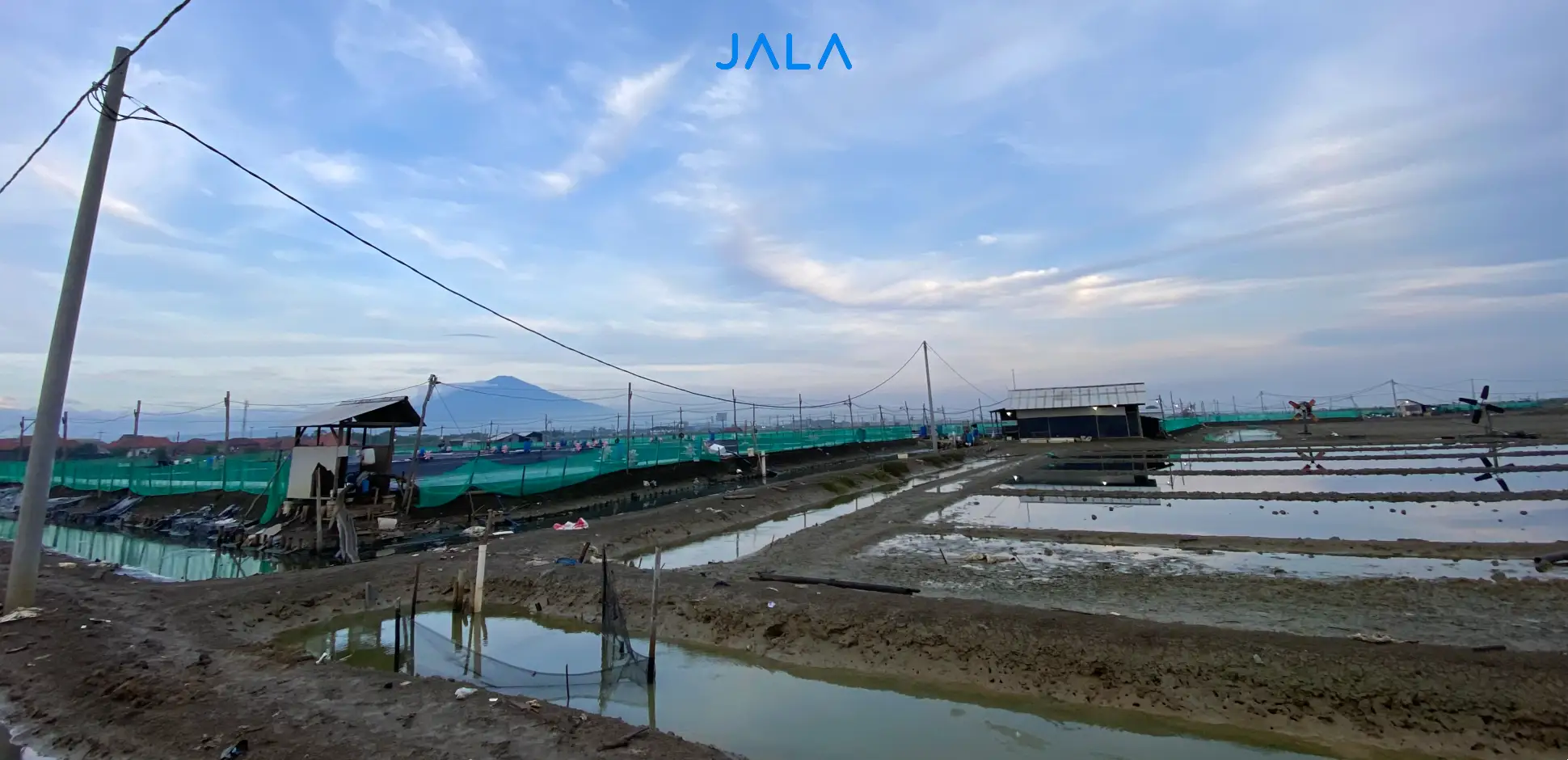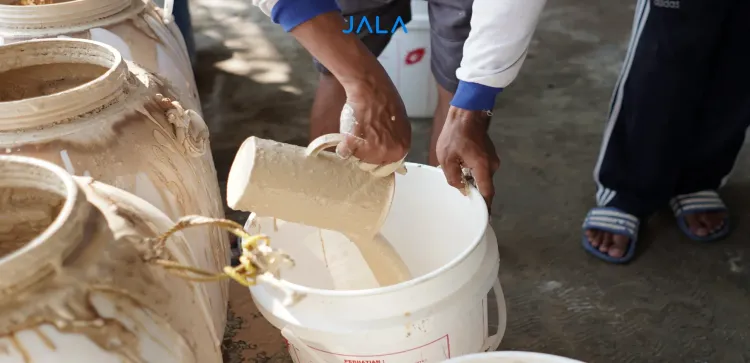
Shrimp remains a popular commodity both in Indonesia and several other countries such as China, the United States, Japan, and many others. Recognizing the wide domestic and international market opportunities, shrimp cultivation efforts in Indonesia continue to be promoted by implementing diverse management, systems, and cultivation technologies among business units. One of these is adopting an intensive system where shrimp are cultivated at high stocking densities in controlled cultivation ponds.
Intensification in shrimp farming demands that practitioners utilize large amounts of feed, substantial oxygen supplies, and the use of chemicals such as fertilizers. Consequently, waste in the form of organic matter or inorganic compounds accumulates, including from feces, excess feed, decomposed organism remains (shrimp and dead algae), and molted exoskeletons. The waste generated within these shrimp cultivation systems exists in solid forms (sediments) like sludge or compounds dissolved in water, such as organic matter, ammonia, hydrogen sulfide, and phosphorus.
The waste produced in shrimp cultivation systems needs proper management to reduce stress levels and the potential for disease outbreaks. One of the easiest techniques to implement is utilizing microorganisms, including probiotic bacteria. This concept is termed bioremediation or the effort to eliminate, reduce, or alter shrimp farming waste through biological processes. The application of bioremediation by leveraging bacteria as biological agents can be implemented through two methods: bioaugmentation and biostimulation,
Bioaugmentation
Bioaugmentation is an effort to introduce microorganisms (bacteria and algae) or living organisms capable of performing biological processes to reduce or transform pollutants from shrimp farming waste into harmless compounds. Probiotic bacteria are bioremediation agents commonly applied in shrimp ponds. Several species of probiotic bacteria have the ability to mineralize organic matter, decrease ammonia levels through nitrification and denitrification processes, and transform aquaculture waste into bacterial biomass that can serve as a nutrient source for shrimp (biofloc).
Organic matter waste in shrimp farming systems typically contains carbon and nitrogen chains. Both of these elements support the growth of various bacterial species such as Bacillus subtilis, Bacillus licheniformis, Bacillus cereus, and Bacillus coagulans. Some of these species are commonly used as commercial probiotic bacteria that can be added to ponds to manage the organic matter waste produced during shrimp cultivation processes.
Ammonia compounds are toxic and become hazardous when their levels exceed 0.01 ppm in intensive shrimp ponds. One method to maintain optimal ammonia levels in shrimp ponds involves adding probiotic bacteria that play a role in the nitrification and denitrification processes. Nitrification rates in ponds need to be optimized to convert ammonia and nitrite (toxic nitrogen compounds) into nitrate through the addition of probiotics containing bacteria from the genera Nitrosomonas, Nitrosococcus, Nitrobacter, and Nitrospira (commercial products contain these genera). Excessive nitrate in the water also needs to be addressed by adding denitrifying bacteria (commercially available genera include Pseudomonas and Bacillus) to convert nitrate into nitrogen gas, which easily evaporates into the atmosphere.
Hydrogen sulfide is another toxic compound found in shrimp farming waste, becoming problematic if its levels exceed 0.01 ppm. The presence of hydrogen sulfide compounds can be controlled by adding photosynthetic bacteria capable of utilizing this compound as a component for cell wall formation or employing it in the photosynthesis process with the help of sunlight. Photosynthetic bacterial species that can be utilized as bioremediators for hydrogen sulfide compounds in shrimp ponds include Rhodobacter capsulatus and Rhodopseudomonas palustris.
Biostimulation
Decomposer bacteria of organic matter (heterotrophic bacteria), nitrifying bacteria, and denitrifying bacteria naturally exist within pond environments. However, under certain conditions, the population of these bacteria fluctuates, resulting in suboptimal management of organic and inorganic waste. One approach for cultivators is to add organic and inorganic nutrients to ponds to stimulate the growth and activity of bioremediation agent bacteria that already exist naturally in the pond environment. This activity is known as biostimulation to maintain the balance of bioremediation bacterial communities within the pond for more optimal degradation processes of organic matter, nitrification, and denitrification.
An easily applicable organic biostimulant product is molasses. Molasses is a byproduct of sugar cane processing containing simple sugars that serve as a carbon source for various heterotrophic bacteria in ponds. The use of molasses in ponds is typically beneficial for cultivating heterotrophic bacteria that form flocs, allowing organic waste to be transformed into food for shrimp. The crucial consideration is the C:N ratio to determine the amount of molasses applied to the pond.
Inorganic biostimulants can also be applied to promote the growth of nitrifying and denitrifying bacteria. One widespread example of an inorganic biostimulant product is urea. Urea fertilizer is commonly used in shrimp ponds to promote plankton growth. However, it has been found that this fertilizer can also stimulate the growth of nitrifying and denitrifying bacteria. Urea contains nitrogen as its main component, and this element is crucial for the growth of nitrifying and denitrifying bacteria in shrimp ponds.
Determining Factors for the Success of Bioaugmentation and Biostimulation
Shrimp pond water conditions are highly complex, resulting from interactions among physical, chemical, and biological components. Several factors below are the most significant factors affecting the success of bioremediation processes through bioaugmentation and biostimulation methods:
- Probiotic products and their appropriate dosage need consideration as they influence the effectiveness of waste decomposition in the ponds.
- Dosage of organic and inorganic biostimulants should be carefully considered to prevent nutrient overload that can lead to algal blooming.
- Adequate oxygen availability is crucial for the survival of shrimp and probiotic bacteria to prevent oxygen competition. This is often addressed by using aerators tailored to the applied farming system and technological level.
- The total accumulated waste in the pond environment. Significant increases indicate a higher waste accumulation rate than the waste breakdown rate by bacteria. This cannot be instantly resolved by adding probiotics but may require water replacement.
- Water quality parameters, such as pH and salinity, affect the performance of waste-degrading bacteria. To maintain a stable pH between 7.5-8.5, regular checks and the addition of lime to increase alkalinity to support pH balance in the ponds are necessary. Excess salinity needs dilution within the pond water. Optimal salinity for vannamei shrimp ponds ranges between 15-25 ppt.
Implementing bioremediation through adding bacterial biomass (bioaugmentation) or nutrient supplements (biostimulation) is not an instant or rapid method in reducing shrimp farming waste. If the waste in the ponds exceeds its threshold, quick water replacement is a recommended action to reduce mortality risks. Bioaugmentation and biostimulation need to align with other management aspects, starting from feed management, shrimp health management, water management, and human resources quality management working in the ponds. Implementing good farming management aims to avoid overfeeding, which often leads to the onset of toxic compounds that can be lethal or reduce shrimp growth and health performance in the ponds.
References
Al-Maliky THY, Al-Maliky AMJ, Al-Maliki GMJ, Boyd CA. 2021. Effects of prebiotic and molasses on water quality, growth and survival of Metapenaeus affinis and Macrobracium nipponense in vitro, without changing water or adding pellets. Egyptian Journal of Aquatic Biology and Fisheries. 25(4):767-783.
Antony SP, Philip R. 2006. Bioremediation in shrimp culture systems. Naga The WorldFish Center Quarterly. 29(3 & 4):62-66.
Chumpol S. 2017. The use of purple nonsulfur photosynthetic bacteria to maintain water quality, sources of single cell protein and bioactive compounds for shrimp cultivation [Doctoral dissertation]. Prince of Songkla University.
De-Paiva Maia, E., Modesto, G. A., Brito, L. O., Galvez, A. O. & Gesteira, T. C. 2016. Intensive culture system of Litopenaeus vannamei in commercial ponds with zero water exchange and addition of molasses and probiotics. Rev. Biol. Mar. Oceanogr. 51(1):61–67.
Jasmin, M. Y., Syukri, F., Kamarudin, M. S., & Karim, M. 2020. Potential of bioremediation in treating aquaculture sludge. Aquaculture. 519:734905.
Kusuma FEP, Sari LK. 2021. Analysis of Competitiveness on indonesian shrimp export to the eight biggest destination countries 2000–2019. Seminar Nasional Official Statistics. 1:695-704.
Panigrahi A, Das RR, Sivakumar MR, Saravanan A, Saranya C, Sudheer NS, Vasagam KPK, Mahalakshmi P, Kannappan, Gopikrishna G. 2020. Bio-augmentation of heterotrophic bacteria in biofloc system improves growth, survival, and immunity of Indian white shrimp Penaeus indicus. Fish & shellfish immunology. 98:477-487.
Rizky PN, Cahyanurani AB, Fahruddin F. 2022. Conformity of technical aspects (construction) of ponds on productivity of intensive vaname shrimp (Litopenaeus vannamei) cultivation at PT. Andulang Shrimp Farm, Sumenep, East Java. Grouper: Jurnal Ilmiah Perikanan. 13(1):26-35.
Srithep P, Khinthong B, Chodanon T, Powtongsook S, Pungrasmi W, Limpiyakorn T. 2015. Communities of ammonia-oxidizing bacteria, ammonia-oxidizing archaea and nitrite-oxidizing bacteria in shrimp ponds. Annals of microbiology. 65:267-278.
Suhendar DT, Zaidy AB, Sachoemar SI. 2020. Dissolved oxygen profile, total suspended solids, ammonia, nitrate, phosphate, and temperature in intensive vannamei shrimp ponds. Jurnal Akuatek. 1(1):1-11.
Suwanpakdee S, Direkbusarakom S, Chotipuntu P, Songsangjinda P. 2010. Urea as a nitrogensource in a black tiger shrimp (Penaeus monodon) closed culture system. Walailak Journal of Science and Technology (WJST). 7(2):135-140.





